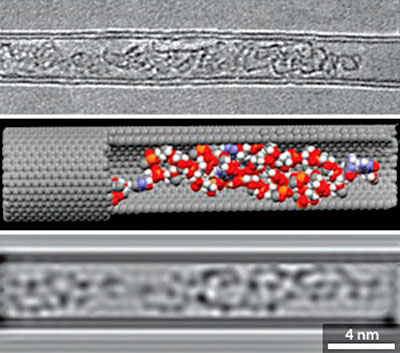|

16 May 2011
from
NatureAsia Website
|
Molecules of single-stranded DNA can be moved into and out of carbon
nanotubes using electric fields. |

A transmission electron microscopy image (top) and simulations
(lower panels)
showing the encapsulation of a DNA molecule in a
double-walled carbon nanotube
Carbon nanotubes are attracting significant interest for biological
and biomedical applications due their low cell toxicity and unique
ability to easily penetrate cell membranes.
These characteristics
make carbon nanotubes potentially ideal vectors for the delivery of biomolecules into living cells. The single-walled nanotubes (SWNTs)
typically examined for such applications, however, are too narrow to
accommodate a useful payload.
Double-walled carbon nanotubes (DWNTs),
on the other hand, have a much larger internal diameter and could be
loaded with a range of complex molecules. DWNTs are also more
mechanically sound and thermally stable compared with SWNTs.
Yongfeng Li and co-workers from Tohoku University in Japan and the
Shanghai Institute of Applied Physics in China have now developed a
method for loading DWNTs with single-stranded DNA and releasing it
under controlled conditions.1
The team was able to move the DNA
molecules into and out of DWNTs using an electric field by changing
the field’s polarity.
The researchers used 30 base-long cytosine homopolymers as the DNA
molecule. Under a positive electric field, the DNA was induced to
enter the 4 nm-wide cavity of the DWNTs in aqueous solution (see
image), where it formed a coil-like structure. Simply applying a
negative electric field then triggered the DNA molecule to be
ejected from the DWNT back into solution.
This system shows considerable promise for the encapsulation and
release of DNA, but the researchers found that the process becomes
increasingly difficult to induce as the number of bases increases.
The team suggests that this resistance to encapsulation may be due
to strong electron stacking interactions between the DNA and the DWNTs
- a resistance that could possibly be overcome by applying a
radiofrequency voltage signal in addition to the direct current
power source to stretch and orient the DNA molecules in a way that
facilitates encapsulation.
Li and his co-workers are already planning the next steps of their
encapsulation research.
“We plan to make conjugates of DNA and gold nanoparticles, which will be encapsulated into carbon nanotubes and
manipulated by laser irradiation of the gold nanoparticle,” says Li.
“We expect the force generated by light pressure to drive the DNA
out of carbon nanotubes.”
Reference
-
Li, Y.1, Chen, S.2, Kaneko, T.1 & Hatakeyama, R.1 Electrically
moving single-stranded DNA into and out of double-walled carbon
nanotubes. Chem. Commun. 47, 2309–2311 (2011). | article
Author affiliation
-
Department of Electronic Engineering, Tohoku University, Sendai
980-8579, Japan
-
Shanghai Institute of Applied Physics, Chinese Academic of
Science, Shanghai, 201800, China
|


